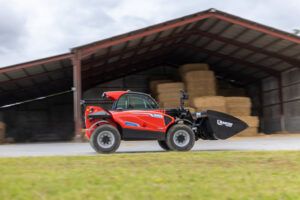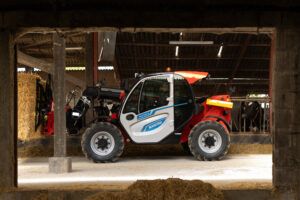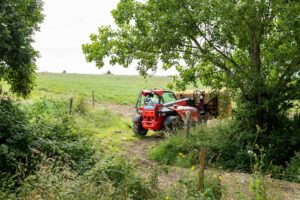French OEM Manitou Group is including to its vary of electrical telehandlers with a zero-emission model of considered one of its best-selling diesel autos for agriculture. Right here we get a primary take a look at the machine and discover out extra in regards to the considering behind its progressive powertrain
Manitou Group is continuous the drive in the direction of electrifying the off-highway sector with its model new MLT 625e, its first battery electrical mounted telehandler for the agricultural sector.
The car, which is predicated on the MLT 625 H diesel equal, is powered by a lithium-ion battery accompanied by two electrical motors. The agricultural model has a 9kW built-in battery charger as commonplace which implies quick charging is extra simply achieved than earlier electrical fashions. Like its diesel counterpart, the MLT 625e is effectively tailored to the agricultural trade with an oscillating rear axle, agricultural tyres, a excessive floor clearance of 38cm and 4 wheel drive. It additionally comes with a full vary of ag attachments together with a bucket, grapple bucket, huge bag handler, sweeper and bale clamp.

This progressive car provides additional advantages for farmers, with zero fumes making it very best for work in shut proximity with animals and different employees. The low noise additionally minimises disruption. When the Group appeared on the design of the MLT 625e, it concerned way more than simply merely swapping the engine for a battery pack. Some of the progressive options is the central positioning of the battery pack, which not solely protects the battery from potential injury throughout operation, but additionally enhances the machine’s stability by centralising the load which is essential throughout lifting operations.
Fairly than merely retrofitting an current diesel mannequin, Manitou redesigned the chassis to accommodate the battery pack. This ground-up strategy to design ensures the electrical telehandler can totally capitalise on the advantages of its energy supply.
On the core of the MLT 625e is a lithium-ion battery which is designed to supply 4 hours of steady work time. The machine’s energy administration system continually screens and adjusts output to maximise effectivity and battery life.

“Within the diesel model, we had the hydraulic pump mounted straight on the engine itself so the engine was all the time operating,” says Damien Rolland, head of the engineering division on the tremendous compact telehandlers product unit. “Within the electrical model, now we have a devoted motor for the hydraulic system. Which means when the operator will not be requesting something, the machine doesn’t run.”
“When hydraulic motion is required, the electrical motor begins operating and it’s linked on to the operator’s wants. For instance, when the operator desires to make a sluggish motion, the motor runs slower and when the person wants full energy, the motor will function at high pace. The power consumption actually will depend on the operator’s requests.”
Battery recharging is assisted by the on-board 9kW charger, which implies the machine might be totally charged in round three hours utilizing a 380V plug. For added comfort, the telehandler comes outfitted with adapters for each 380V and 220V plugs, making certain compatibility with varied farm setups.
The fast-charging functionality reduces downtime and will increase general productiveness. The pliability in charging additionally permits farmers to combine the MLT 625e seamlessly into their day by day operations with out the necessity for main infrastructure modifications. “Alternative charging means we are able to cost the machine every time we wish and it additionally implies that we don’t have to totally cost the machine every time,” says Camille Rouvrais, a product supervisor at Manitou Group. “There is no such thing as a particular charging room wanted or further upkeep.”
“We now have a devoted motor for the hydraulic system. Which means when the operator will not be requesting something, the machine doesn’t run”
The MLT 625e has been designed to match the capabilities of its diesel counterpart with a lifting capability of two,500kg and most lifting top of 5.9m, in addition to its general hydraulic efficiency.
“In comparison with the diesel model, the traction energy is barely decreased,” says Rolland. “However, the electrical model is way more reactive, so we don’t really feel now we have a major lack of energy. The facility is greater than sufficient for agricultural functions.”

Security options
The MLT 625e incorporates superior options to guard each the operator and the machine. The mixing of a battery administration system (BMS) is on the coronary heart of those security measures.
The true-time communication between the BMS and the machine’s central management system makes energy output changes primarily based on battery situations and operator calls for. If the battery cost is low or if temperature situations are suboptimal, the system can restrict energy output to forestall injury and guarantee continued operation.
“The BMS sends info to the machine’s system. The system then assesses the operator’s request and the battery capability and adapts the request accordingly. If the request is in steadiness with the battery capability, the motion will likely be as requested. If the battery can’t ship the facility wanted, the motion will likely be decreased,” says Rolland.
The MLT 625e additionally options thermal administration methods to keep up optimum battery temperature. A small radiator and fan system assist regulate the temperature of the traction motor and hydraulic oil, whereas additionally offering cooling for electrical elements within the car.
“Alternative charging means we are able to cost the machine every time we wish and don’t have to totally cost it every time”
Moreover, Manitou Group has applied measures to guard {the electrical} elements from mud, particles and moisture which may probably trigger put on and injury and are fixed hazards in agricultural. “All {the electrical} elements have an IP65 ranking and most of them are situated underneath the engine bonnet to guard them from rain, dust, mud and particles. We now have additionally designed a canopy for
the motor which provides safety towards hostile climate situations,” says Rolland.
The electrical powertrain within the MLT 625e means a lot much less upkeep is required when in comparison with a conventional diesel machine, without having for engine oil modifications or gasoline filter replacements. This not solely reduces downtime, but additionally lowers the full price of possession
for the farmers.
The change to electrical has resulted in a considerably quieter operation. This discount in noise makes the telehandler well-suited for indoor operations, comparable to in barns or different enclosed agricultural areas.
The introduction of the MLT 625e aligns with Manitou Group’s goal to have 43% of its product vary bought as low emission by 2030. “When it comes to sustainability, we’re already making strikes within the building sector, and we purpose to do precisely the identical within the agricultural sector,” says Franck Lethorey, who’s exterior communication supervisor for the Manitou Group. “We now have a devoted low-carbon pathway which has been validated by the SBTI organisation. It’s actually vital for us to speed up the deployment of our electrical ranges and we’re presently within the technique of engaged on hydrogen prototypes. We even have a well-established CSR coverage. This can be our first agricultural telehandler launch, however we’re centered on our complete world technique.”
This text first appeared within the August challenge of iVT Worldwide – https://markallen.mydigitalpublication.co.uk/publication/?m=63192&i=827328&p=1&pre=1&ver=html5


